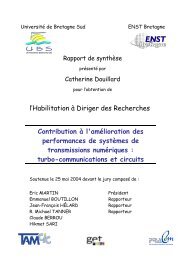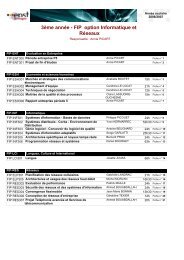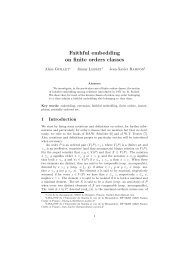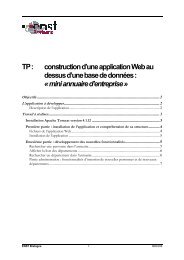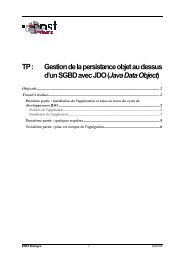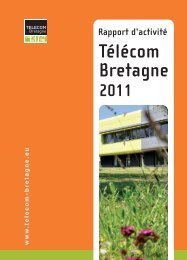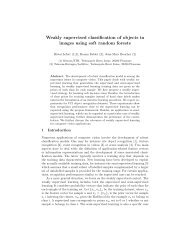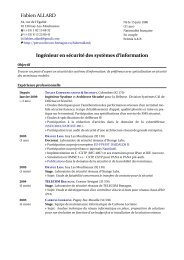researResearch - Télécom Bretagne
researResearch - Télécom Bretagne
researResearch - Télécom Bretagne
You also want an ePaper? Increase the reach of your titles
YUMPU automatically turns print PDFs into web optimized ePapers that Google loves.
h Research<br />
9<br />
RESEARCH<br />
Main achievements of the project<br />
TRIDENT<br />
The (TRIDENT) system was designed and<br />
developed for GESMA 2 to transmit data, speech<br />
and images. Studies into the improvement of the<br />
high data rate link are necessary to arrive at a<br />
viable commercial product. Efforts have been<br />
made on the encoding of speech using forward<br />
error correcting encoders (convolutionnal<br />
encoding, Reed-Solomon and turbo-codes).<br />
Transmission and reception platforms, built<br />
around the TMS320C6201 signal processor of<br />
Texas Instruments, have been developed.<br />
Timing and Carrier frequency recovery<br />
schemes<br />
The thesis of Goulven Eynard defended on 19th<br />
December 2008 dealt with the performance<br />
improvement of modems in the case of ship<br />
movements. Robust synchronization algorithms<br />
exploiting the specificities of underwater acoustic<br />
channels were developed to combat the Doppler<br />
effect, which deformed the received signal in time<br />
and frequency. By showing that these time and<br />
frequency deformations are linked, a joint timing<br />
and carrier frequency recovery algorithm was<br />
proposed. Another contribution concerned a<br />
system of timing recovery capable of exploiting<br />
spatial diversity to follow Doppler drifts, while<br />
showing a different sampling instant on each<br />
antenna. The algorithms proposed were tested<br />
and validated on real sea trials.<br />
Characterisation of time-varying<br />
underwater acoustic communication<br />
channel<br />
A CIFRE thesis with Thales Underwater Systems<br />
began in November 2008. The first axis of study<br />
concerned the statistical properties of the<br />
underwater acoustic communication channel. For<br />
this we used a database of coastal waters<br />
measurements. Analysis of these data allowed us<br />
to infer that the channel behaves as a random<br />
process characterized by (pseudo) determinist<br />
non-stationarities. Statistical tests showed that<br />
the channel paths follow the Rice law with a ratio<br />
between the average part and the diffused part<br />
which fluctuates with time and in function of the<br />
delay of the path in question.<br />
Time-reversal method<br />
Dr Haibin Wang from the "Chinese Academy of<br />
Sciences", Beijing, is spending a sabbatical year<br />
in the Signal and Communications Department,<br />
studying the possibilities of using time-reversal<br />
technique in underwater acoustic<br />
communication.<br />
Covert transmissions<br />
Within the framework of this thesis, we studied<br />
the performance of receivers for discrete<br />
transmissions with spectrum spread. A new<br />
technique of channel estimation for transmission<br />
by spectrum spread was proposed. The approach<br />
held used Lagrange interpolation filters and<br />
allowed to improve channel estimation quality<br />
which was used to produce the RAKE receiver.<br />
Optimisation of the power allocation between the<br />
pilots and the information data is also considered<br />
in this thesis.<br />
143<br />
2) GESMA : Groupe d'études sous-marines de l'Atlantique



